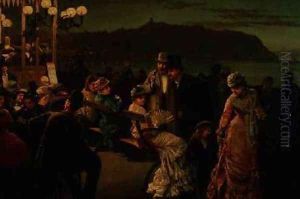F. Sydney Mauchamp Paintings
F. Sydney Muschamp, full name Frederick Sydney Muschamp, was an English painter and watercolourist known for his idyllic and pastoral scenes, often featuring feminine beauty in lush landscapes. Born in 1867, Muschamp grew up during a period in British art history that was heavily influenced by the aesthetic movements of the late 19th century, which celebrated beauty and nature through art and design. This cultural backdrop heavily influenced Muschamp’s artistic development and the subjects he was drawn to.
Muschamp received his formal art education at the Royal Academy Schools, a prestigious institution that has nurtured many of Britain's most significant artists. His time at the Royal Academy allowed him to refine his technique and develop his distinctive style, which blends classical artistic principles with a romanticized portrayal of the English countryside and its inhabitants. Muschamp's work often depicted young women and children in outdoor settings, capturing the transient effects of light and atmosphere with a delicate touch and subtle palette.
Despite his talent and the quality of his work, Muschamp did not gain the same level of fame as some of his contemporaries. However, he was respected in artistic circles and participated in numerous exhibitions throughout his career. His paintings were showcased at the Royal Academy and the Royal Society of British Artists, among other venues, earning him recognition and accolades from his peers.
Muschamp's artistry extends beyond his watercolours and paintings; he also contributed illustrations to various publications, a common practice among artists of his time to reach a wider audience. These illustrations further highlight his skill in capturing human emotion and the beauty of nature.
Frederick Sydney Muschamp passed away in 1916, leaving behind a body of work that, while perhaps not as widely known today, represents an important facet of late Victorian and Edwardian art in Britain. His paintings continue to be appreciated by collectors and art historians for their elegance, technical skill, and the serene beauty they encapsulate, offering a glimpse into the tranquil and picturesque vision of England at the turn of the 20th century.
